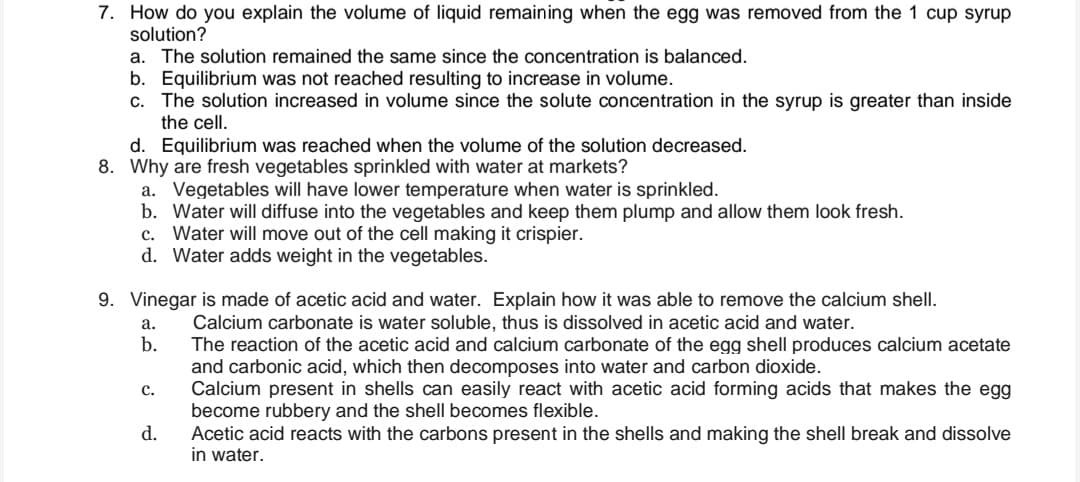7. How do you explain the volume of liquid remaining when the egg was removed from the 1 cup syrup solution? a. The solution remained the same since the concentration is balanced. b. Equilibrium was not reached resulting to increase in volume. c. The solution increased in volume since the solute concentration in the syrup is greater than inside the cell. d. Equilibrium was reached when the volume of the solution decreased. 8. Why are fresh vegetables sprinkled with water at markets? a. Vegetables will have lower temperature when water is sprinkled. b. Water will diffuse into the vegetables and keep them plump and allow them look fresh. c. Water will move out of the cell making it crispier. d. Water adds weight in the vegetables. 9. Vinegar is made of acetic acid and water. Explain how it was able to remove the calcium shell. Calcium carbonate is water soluble, thus is dissolved in acetic acid and water. The reaction of the acetic acid and calcium carbonate of the egg shell produces calcium acetate and carbonic acid, which then decomposes into water and carbon dioxide. Calcium present in shells can easily react with acetic acid forming acids that makes the egg become rubbery and the shell becomes flexible. Acetic acid reacts with the carbons present in the shells and making the shell break and dissolve in water. а. b. с. d.
7. How do you explain the volume of liquid remaining when the egg was removed from the 1 cup syrup solution? a. The solution remained the same since the concentration is balanced. b. Equilibrium was not reached resulting to increase in volume. c. The solution increased in volume since the solute concentration in the syrup is greater than inside the cell. d. Equilibrium was reached when the volume of the solution decreased. 8. Why are fresh vegetables sprinkled with water at markets? a. Vegetables will have lower temperature when water is sprinkled. b. Water will diffuse into the vegetables and keep them plump and allow them look fresh. c. Water will move out of the cell making it crispier. d. Water adds weight in the vegetables. 9. Vinegar is made of acetic acid and water. Explain how it was able to remove the calcium shell. Calcium carbonate is water soluble, thus is dissolved in acetic acid and water. The reaction of the acetic acid and calcium carbonate of the egg shell produces calcium acetate and carbonic acid, which then decomposes into water and carbon dioxide. Calcium present in shells can easily react with acetic acid forming acids that makes the egg become rubbery and the shell becomes flexible. Acetic acid reacts with the carbons present in the shells and making the shell break and dissolve in water. а. b. с. d.
Biology: The Dynamic Science (MindTap Course List)
4th Edition
ISBN:9781305389892
Author:Peter J. Russell, Paul E. Hertz, Beverly McMillan
Publisher:Peter J. Russell, Paul E. Hertz, Beverly McMillan
Chapter5: Membranes And Transport
Section: Chapter Questions
Problem 5TYK: A driving ion moving through a membrane channel in one direction gives energy to actively transport...
Related questions
Question

Transcribed Image Text:7. How do you explain the volume of liquid remaining when the egg was removed from the 1 cup syrup
solution?
a. The solution remained the same since the concentration is balanced.
b. Equilibrium was not reached resulting to increase in volume.
c. The solution increased in volume since the solute concentration in the syrup is greater than inside
the cell.
d. Equilibrium was reached when the volume of the solution decreased.
8. Why are fresh vegetables sprinkled with water at markets?
a. Vegetables will have lower temperature when water is sprinkled.
b. Water will diffuse into the vegetables and keep them plump and allow them look fresh.
c. Water will move out of the cell making it crispier.
d. Water adds weight in the vegetables.
9. Vinegar is made of acetic acid and water. Explain how it was able to remove the calcium shell.
Calcium carbonate is water soluble, thus is dissolved in acetic acid and water.
The reaction of the acetic acid and calcium carbonate of the egg shell produces calcium acetate
and carbonic acid, which then decomposes into water and carbon dioxide.
Calcium present in shells can easily react with acetic acid forming acids that makes the egg
become rubbery and the shell becomes flexible.
Acetic acid reacts with the carbons present in the shells and making the shell break and dissolve
in water.
а.
b.
с.
d.
Expert Solution
This question has been solved!
Explore an expertly crafted, step-by-step solution for a thorough understanding of key concepts.
This is a popular solution!
Trending now
This is a popular solution!
Step by step
Solved in 5 steps

Recommended textbooks for you

Biology: The Dynamic Science (MindTap Course List)
Biology
ISBN:
9781305389892
Author:
Peter J. Russell, Paul E. Hertz, Beverly McMillan
Publisher:
Cengage Learning

Biology 2e
Biology
ISBN:
9781947172517
Author:
Matthew Douglas, Jung Choi, Mary Ann Clark
Publisher:
OpenStax

Biology: The Unity and Diversity of Life (MindTap…
Biology
ISBN:
9781305073951
Author:
Cecie Starr, Ralph Taggart, Christine Evers, Lisa Starr
Publisher:
Cengage Learning

Biology: The Dynamic Science (MindTap Course List)
Biology
ISBN:
9781305389892
Author:
Peter J. Russell, Paul E. Hertz, Beverly McMillan
Publisher:
Cengage Learning

Biology 2e
Biology
ISBN:
9781947172517
Author:
Matthew Douglas, Jung Choi, Mary Ann Clark
Publisher:
OpenStax

Biology: The Unity and Diversity of Life (MindTap…
Biology
ISBN:
9781305073951
Author:
Cecie Starr, Ralph Taggart, Christine Evers, Lisa Starr
Publisher:
Cengage Learning

Anatomy & Physiology
Biology
ISBN:
9781938168130
Author:
Kelly A. Young, James A. Wise, Peter DeSaix, Dean H. Kruse, Brandon Poe, Eddie Johnson, Jody E. Johnson, Oksana Korol, J. Gordon Betts, Mark Womble
Publisher:
OpenStax College

Biology: The Unity and Diversity of Life (MindTap…
Biology
ISBN:
9781337408332
Author:
Cecie Starr, Ralph Taggart, Christine Evers, Lisa Starr
Publisher:
Cengage Learning

Cardiopulmonary Anatomy & Physiology
Biology
ISBN:
9781337794909
Author:
Des Jardins, Terry.
Publisher:
Cengage Learning,